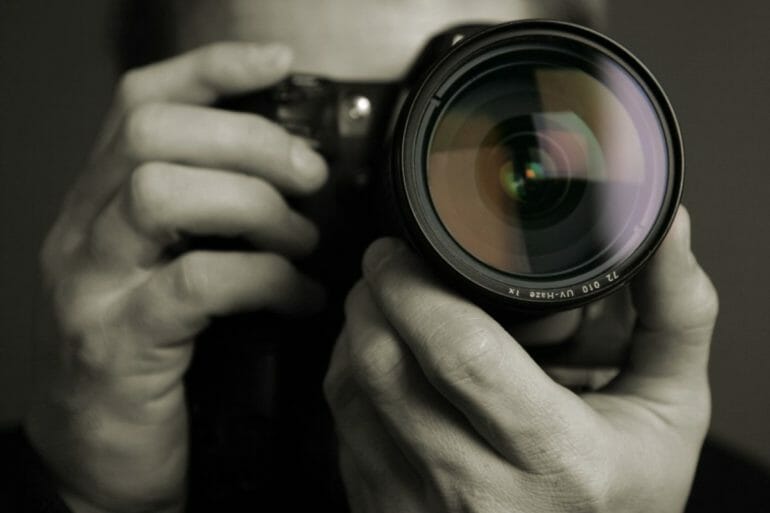I liked going out with girls, and I liked taking pictures, so which one do I wanna make money from?
elliott landy
Thanks to advancements in recording technology throughout the years, along with the amazing ability to carry our music collection with us, we can hear the history behind the music at the drop of a hat in a number of different ways, but the magic of musical movements is never only isolated to the music itself.
Rather, the great moments in music are often defined by incredibly detailed aesthetics and how these aesthetics relate to political and social contexts.
This is why being able to see music history is almost as essential as being able to hear it. And when it comes to what is arguably the most significant development in modern music, we owe one man, in particular, a huge debt of gratitude… Mr. Elliott Landy.
One of the first music photographers to ever be referred to as an “artist”, Elliott Landy’s documentation of music culture in the 60s and beyond was and still is of crucial importance.
Yet, as the man behind the camera, he doesn’t get nearly enough attention, which is why, today, I’ll be shining the spotlight on him for a change.
Shutterbug Beginnings
Landy was born in 1942 somewhere in the USA. No information more specific than that is readily available, but as he graduated from the Bronx High School of Science, we can assert two things with relative certainty.
- He was born either in or around the Bronx borough or otherwise moved to the area at a young age — His thick New York accent in interviews backs this theory up.
- He was an incredibly gifted child.
See, the BHSoS is no ordinary high school; it’s a specialist school that accepts only 800 of 30,000 applicants each year, celebrates seven Pulitzer Prize-winning alumni, and currently holds the world record for the most Nobel Prize-winning alumni (eight, if you’re wondering).
So, yeah… little Landy must have been something of a prodigy.
After graduating, Elliott landed a spot in The Baruch College affiliated with the City University of New York.
What he studied during his time in college is unknown, but whatever qualification he received upon graduation didn’t pan out in his favor at first, as he ended up accepting a dead-end office job.
When Elliott Landy Picked Up His First Camera
One day, Elliott Landy was walking down Broadway when he saw “something beautiful” on the side of a building.
He glanced around for someone to point it out to, but alas, there was no one he knew, and in that disheartening moment, he had an epiphany… If he had a camera, he could freeze images such as the one he’d just seen and share them with his friends and family at a later date.
What the “something beautiful” he saw was is just another of the many unknowns surrounding Landy, but the important thing is that a seed was planted in his thoughts — He had to get a camera.
Now, though dull, his office job provided the means to head out and pick a camera up right away, and just as quickly, Landy fell head over heels for photography.
He worked in his tedious position a while longer but swiftly came to the conclusion that he couldn’t possibly forge a career out of work he wasn’t passionate about.
He would remark years later in an interview:
I realized that in order for me to exist, I had to do something I liked to do.
So I asked myself… I thought, well what do I like to do?
I liked going out with girls, and I liked taking pictures, so which one do I wanna make money from?
RELATED: Richard Manuel – Life in The Band
Political Journalism: An Unlikely Road To The Heart Of American Music
With this new dream still fresh in his mind, Elliott quickly secured a position as the photographer on the set of a Danish feature film, and when he returned to New York, used the clippings to land a few assignments for various magazines.
But the real reason he came back to the States was to do his part to protest and stop the Vietnam War…
“My first thought was: I’d go to Vietnam and show people how bad war is. My second thought was: I don’t want to do that — be shot at or killed. I don’t want to be anywhere near this stuff.”
Instead, chose a poignant related, but entirely safer, subject — the peace demonstrations in the US.
He noticed that there was barely any coverage of such events in major media publications, and when there was a paragraph or two dedicated to the protests, there were no pictures, which he felt was criminally and harmfully reductionist.
When he himself produced the necessary images, he met fierce resistance… “I took my pictures to the mainstream news agencies, but nobody was interested.”
Determined to contribute to the peace efforts, he began working with underground newspapers who did welcome his offerings, leading to his acquiring a New York City Police Press Pass.
This pass granted him immunity from arrest wherever in the city he was taking pictures, but it was so, so much more than a get-out-of-jail-free card.
What Elliott Landy had been handed that day was also a skeleton key to any and every gig in town!
Country Joe And The Fish Light Show & Beyond
One evening after working his peace-tinged political angle, Landy saw an Anderson Theater marquee advertising a Country Joe and the Fish Light Show…
“I said, ‘What’s Country Joe and the Fish?’ I had no idea. I walked over to the box office and heard this loud music coming out of the auditorium. I had my press pass with me, and I walked into this unbelievably beautiful light show and incredible amplified sound. I was smitten by it. I had my camera and went up to the front of the theater and started taking pictures. That was the beginning.”
The next show he flashed his pass to attend was Janis Joplin with Big Brother and the Holding Company, whom he decided to shoot in infrared, an approach that seemed to hold a mirror to the experimentalist nature of the sounds he was hearing.
After seeing Elliott’s Joplin snaps, legendary band manager Albert Grossman invited the young visionary to photograph The Band, just one of his many popular clients.
The pictures from this shoot were then chosen for The Band’s Music From Big Pink record, and as word got out about Landy’s unique talent, he was granted private shoots with even bigger stars, such as Bob Dylan.
When one of the photos of that shoot was subsequently published on the cover of the ‘68 edition of the Saturday Evening Post, Landy’s star rose ever higher and shone ever brighter.
All the while, he continued attending gigs, capturing iconic shots at live shows across the city. During this time period, he photographed the likes of Jimi Hendrix, Jim Morrison, Eric Clapton, Santana, John Lee Hooker, Frank Zappa, Janis Joplin (again), Joan Baez, and Van Morrison.
He also provided photo coverage of the now infamous 1969 Woodstock concert, a gathering of like minds with the ultimate goal of spreading the message of unity and peace, and it was Landy who helped to deliver said message to the world.
RELATED: 10 Photos Of Jimi Hendrix & Carmen Borrero
Did Elliott Landy Abandon Political Journalism For Music Journalism?
Although taking pictures of musicians was certainly a shift in process, Elliott Landy never differentiated his work within the music industry from the overtly political work he was also engaged in.
To him, the music was part of the anti-war movement, and thus, whether he was photographing a concert or a demonstration, he was always capturing the essence of resistance.
“The performers were against the war, as was the audience. When you went to the Fillmore East, it was like joining an alternative universe of experience. Everyone welcomed each other, were considerate of each other — you were one with a group of like-minded people.”
The Real-World Impact Of Elliott Landy’s Work
Granted, it was the music of the 60s and 70s that defined generations, but for many, Landy’s photojournalism served as the portal to the life-changing sounds and philosophies of the early rock and folk explosion.
He had become the unofficial visual voice of the flower power movement and its many facets, not just the music, but the lifestyle and the ethos.
Landy put it perfectly himself when he said that he “was proselytizing, inviting people to come to the concerts and experience the music. It expanded your brain, expanded how you perceived and felt things.” And arguably, even though we can’t rock up to a Joplin or Hendrix gig these days, this is what his work is still doing.
When Elliott Landy Left Music Behind
It’s quite common for successful photographers to dedicate their entire career to one general subject, but there came two signs in the mid to late 70s when Elliott Landy knew it was time to find a new muse…
I was taking a photograph one time for an assignment. As I was taking the picture, I was thinking about what the art director wanted —
And the second thing that happened was when I caught myself thinking about how I could sell a picture while I was taking it.
He could feel his artistic integrity dissipating, something he was and still is unwilling to sacrifice, least of all for a paycheck.
He opened a gallery in Woodstock that only stocked his nature shots, then took a break from photography altogether, instead trying his hand at painting and immersing himself in spiritual writings.
When his wife became pregnant, she and motherhood were new muses worthy of picking the camera back up, and when his child was born, they inherited the attention of his lens, as did the next.
These days, he only snaps surreal impressionist shots of flowers and food with a smile on his face and his integrity intact.
The Band Photographs, 1968 – 1969. Volume 2 – Kickstarter Campaign
As the only photographer who had access to The Band during the period they were making their first two albums, Elliott Landy is seeking funding for his second volume of photographs of The Band.
The Band Photographs, 1968-1969 Volume 2 will be a companion to the first volume, The Band Photographs, 1968-1969, which Landy published in 2015. The new book will contain nearly 200 never-before-published photographs of The Band, shot by Landy during his time living in Woodstock, NY, and hanging out with the band members.
There will be two editions of the book: a Signature Edition ($85) and a Deluxe Edition ($400). Both editions will have the same high-quality paper and Fine Art Printing as the first volume.
The Signature Edition will be signed by Landy, while the Deluxe Edition will come in a handmade clamshell box and include a limited edition fine art print, as well as a signed and numbered book.
If you’re a fan of The Band or a photography enthusiast, supporting Elliott Landy’s Kickstarter campaign for The Band Photographs, 1968-1969 Volume 2 is a great way to show your appreciation for his work and help expand The Band’s legacy.
Visit the campaign page today and make a pledge!
Final Thoughts
It might sound corny to say that Elliott Landy weaponized light to disperse darkness, but that’s quite literally and figuratively what he and his camera did.
His pictures opened the eyes of a nation blinded by conservative mainstream media, creating and connecting communities by spreading awareness of counterculture music.
His days of snapping rock stars may be long behind him, but, remember, Elliott Landy chose photography because of its permanence.
We can all dive into one of his many books and see the numerous beautiful things this beautiful mind thought worthy of preservation.
And with that said, there’s only one thing left for me to write…
Thank you, Elliott.
PS. Check out this clip of Elliott Landy speaking about his life and work on Coastal A&E with Michael Sprouse.
- The 25 Richest Rock Stars in the World | A Rock And Roll Rich List - February 22, 2024
- Rock And Roll Movies | 20 Films That Will Rock Your World - February 19, 2024
- The Biggest One Hit Wonders In Rock History - February 16, 2024


